The NTUC Income RUN350, organised by Young NTUC, takes place on 5 April – in less than two months time. So to prepare runners for this event, a series of running clinics have been organised by the official pacers of RUN350 – the Earth Runners.
The first running clinic took place yesterday at One Marina Boulevard in Raffles Place, and featured competitive runner Melvin Wong – a sales associate at Bloomberg who won the Adidas King of the Road race in 2012, so he’s commonly known as the King of the Road. Dr Derek Li, a medical doctor who represented Singapore at the Macau Marathon in 2014, was the other speaker there.
Wong shared with runners, some tips about getting past a running plateau while Li imparted knowledge on nutrition and tapering strategies. Here are the main highlights of what the two speakers said, at the running clinic.
Apart from the theory sessions conducted by the two elite runners, a 5.5km practical run was also held. This was led by both Wong and Li, after their talk.
Melvin Wong: Getting Past a Running Plateau
According to Wong, getting stuck and unable to improve on their timing despite the fact that they’re training as hard as they possibly can, is something that many runners fear.
The PRIME Framework
In order to get past a running plateau, Wong recommends that runners can utilise the PRIME framework, which he says helped him to review his own personal running when he was plateauing.
The abbreviation for PRIME stands for:
P – Priority
R – Resources
I – Internal Expectations
M – Milestones
E – Execution
Priority is about making a list of what you deem to be most important. For example, Wong views focused training, quality sleep and using weekends as family time, as his top three priorities. Then he says that you would accommodate everything else around these priorities in life. “And if I pen it down on paper, then I am accountable for it,” he adds.
Resources is about what is available to you, in order to improve as a runner and break your plateau. For example, having a running coach and incorporating strength training into your running routine. As well, Wong also adds that he looks to sprinters for inspiration – because unlike distance runners, sprinters have very good running form with a straight posture, full velocity and long strides, that help them to go really fast. “I don’t want to falter and have my hips swaying from side to side when I am running. I want to keep my form as close as possible to sprinters,” Wong adds.
Internal expectations is all about the pressure that you put on yourself as a runner, for example, achieving a marathon target pace of 4:15 minutes per kilometre. However Wong adds that these expectations must be achievable.
Milestones refer to your long-term goals and targets as a runner. For example, your goal may be to break the 20-minute barrier for 5km within about six months. And to achieve this, you may gradually increase your core exercises from three minutes a day to 15 minutes a day, to slowly build up the strength to achieve this. And halfway down the road, say three months, Wong recommends doing a tune-up 5km, targeting 22 or 23 minutes, to check whether you are on target to achieving your running goals.
Execution, the final stage in Wong’s PRIME framework, is about looking into executing a successful race strategy to meet your goals and targets. To achieve this, Wong adds that by no means should you procrastinate, for example, on training as this will affect your ability to perform. At the same time, using trial and error to test and try out new things is very important because it will help you to figure out, for example, what’s the best combination of post-workout drinks and energy gels for you.
Dr Derek Li: Pre-Race Nutrition and Tapering Strategies
Tapering
While Li feels that tapering is important for distance runners, he added that most runners tend to over taper rather than under taper. Over tapering means that they taper too early and/or do too little exercising during the taper phase. However, over tapering has its pitfalls too because it leaves you feeling sluggish on race day and unable to perform at your best. On the other hand though, under tapering will too prevent you from reaching your maximum potential because you will still feel some soreness in your legs on race day from inadequate rest.
One thing that most running coaches agree on though, is that the higher your main weekly volume is during your peak phase, the longer your tapering period should be. For example, if your peak training volume is between 30 to 60 kilometres, you should taper for one week. If it is between 60 to 80 kilometres, the taper phase should last for two weeks, and so on, according to Li.
Also, your last long run, typically of more than one and a half hours, before race day should be no less than seven days before the race. That’s because running for such durations will deplete the carbohydrate stores in the body and it will not be fully replenished in time for the race.
At the same time, Li added that you should not do any more hard training sessions in the week leading up to the race, because it will have zero impact on your race day fitness and will only serve the wear and tire the body out instead.
Nutrition
The doctor also explained that it is important to maximise your glycogen stores during the pre-race loading phase. While carbohydrate and fat loading are important though, a runner also needs to maintain his or her race weight. “I struggle with maintaining my body weight during the tapering phase as I am eating more, but running less. So my weight simply balloons up,” Li added.
He also said that there are two types of loading – fat loading and carbohydrate loading. Fat loading usually lasts a few days and precedes the carbo loading phase. It comprises of eating foods high in healthy fats such as nuts, cheese and avocados. During fat loading, the runner also cuts out carbohydrate-rich foods so that the body will use up the fat stores instead. The purpose of fat loading is to enable the body to store glycogen more efficiently in the few days leading up to the race.
Three days before the race, carbo loading takes place. The purpose of carbo loading is to maximise the sugar content stored by the body to provide sufficient energy on race day. However, Li pointed out that you should not consume too much carbohydrates during this period though, because the excess gets converted to fats. For example, if your body can store 2,000 calories of carbohydrates and you consume 2,500 calories, then the additional 500 calories will turn into fat.
During the first few days of carbo loading, it is important to consume complex carbs such as brown rice and brown bread but in the hours before the race, eat only simple carbohydrates because these get digested very fast, thus preventing stomach-induced problems such as constipation during the race.
“As well, don’t forget to drink during the carbo loading phase. Carbs are high in fibre so you must drink. Otherwise the fibre in the carbs will become a big, solid mass in the body and cause constipation problems,” Li added.
The Final Countdown Before The Race
It is very important to get adequate sleep in the days leading up to the race. For example, if the race is on a Sunday, try to get about eight to ten hours of sleep on Thursday and Friday night. If you do so, it won’t matter that you got only three hours of sleep on Saturday night due to over-excitement.
As well, the doctor advises runners to rest completely and also stay hydrated on the day before the race in order to optimise the race day performance. “I am very boring just before a race – I stay in bed and watch TV all day long,” Li quipped.
Then on the morning of the race, wake up four hours before the flag off time and consume a light breakfast meal comprising plenty of simple carbs, and no more than 300 calories. Li added that if you consume too much, it may lead to stomach cramps and other problems during running. If you still need to eat something later on, for instance in the half hour before you are due to run, the doctor recommends consuming energy gels as these are the easiest forms of carbohydrates for the body to digest.
A Practical Running Session
After the talk, together with the official RUN350 pacers, Wong also led runners on a practical warm-up session followed by an easy, scenic 5.5km run around the Gardens by the Bay and the Marina Barrage area. And after the run, Li took the participants through a cool-down session.
They did plenty of exercises with the participants. Wong’s warm-up exercises largely included dynamic running drills such as knee lifts and walking lunges. The purpose of dynamic drills help to stretch the muscles more efficiently and prevent injury, compared to static drills.
Afterwards, Li’s cool-down session comprised of static exercises to stretch the major leg muscles, such as the hamstrings, the quads and the achilles heel. The purpose of these exercises are to help the body transition from an active state to a resting state – to prevent muscle stiffness after completing the exercise session.

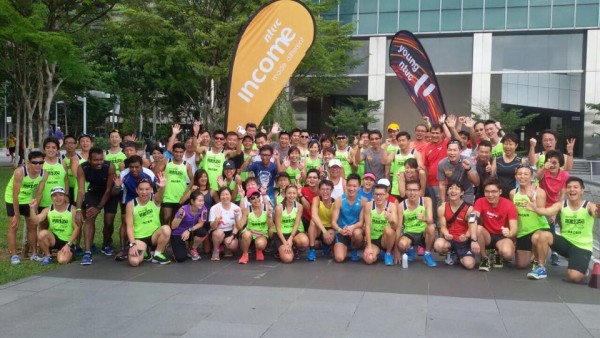
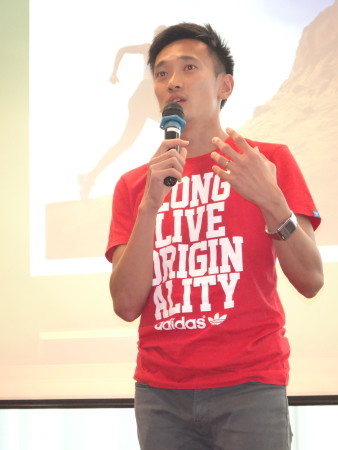
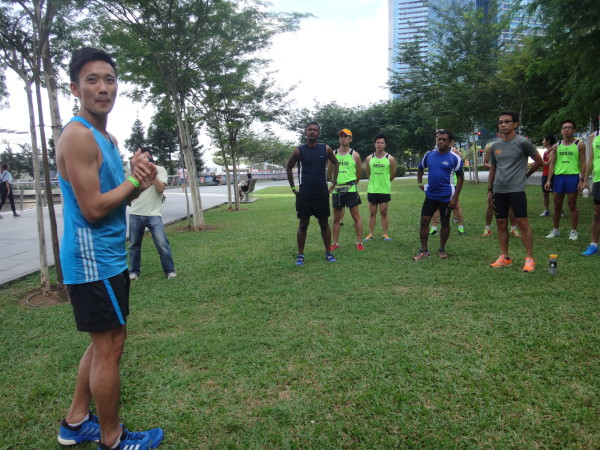

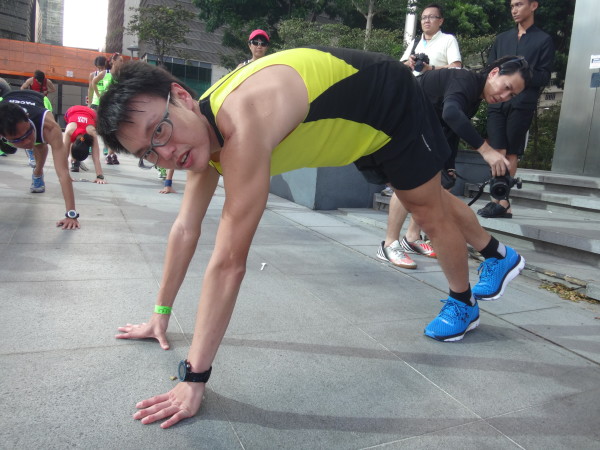
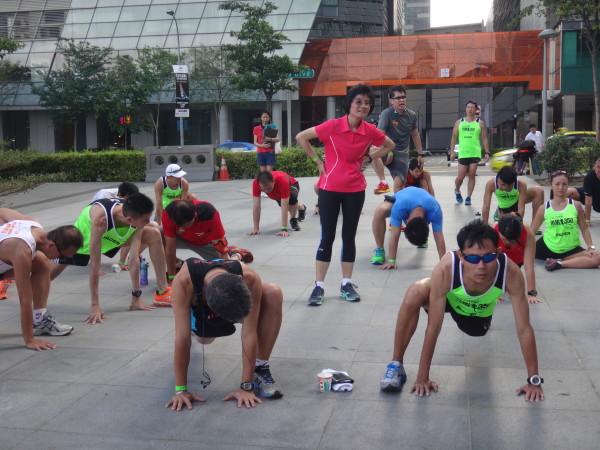
Leave a Comment